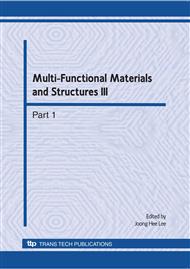[1]
Y. Chen, Torsion of nonhomogeneous bars. J Franklin Institute 1964; 277: 50-54.
DOI: 10.1016/0016-0032(64)90038-9
Google Scholar
[2]
C. O. Horgan, A. M. Chan, Torsion of functionally graded isotropic linearly elastic bars. Journal of Elasticity 1999; 52: 181-199.
Google Scholar
[3]
I. Ecsedi, Some analytical solutions for Saint-Venant torsion of non-homogeneous cylindrical bars. European Journal of Mechanics A/Solids (2009), doi: 10. 1016/j. euromechsol. 2009. 03. 010.
DOI: 10.1016/j.euromechsol.2009.03.010
Google Scholar
[4]
S. Arghavan, M. R. Hematiyan, Torsion of functionally graded hollow tubes. European Journal of Mechanics A/Solids (2008), doi: 10. 1016/j. euromechsol. 2008. 067. 009.
DOI: 10.1016/j.euromechsol.2008.07.009
Google Scholar
[5]
J. F. Ely, O. C. Zienkiewicz, Torsion of compound bars - a relaxation solution. International Journal of Mechanical Science, vol. 1, pp.356-365 (1960).
DOI: 10.1016/0020-7403(60)90055-2
Google Scholar
[6]
V. D. Kupradze, M. A. Aleksidze, The method of functional equations for the approximate solution of certain boundary-value problems (in Rusian). Zurnal Vycislennoj Matematiki i Matetyczeskoj Fizyki, 4, 683-715, (1964).
DOI: 10.1016/0041-5553(64)90006-0
Google Scholar
[7]
R. Mathon, R. L. Johnston, The approximate solution of elliptic boundary-value problems by fundamental solutions. SIAM Journal on Numerical Analysis, 14, 638-650, (1977).
DOI: 10.1137/0714043
Google Scholar
[8]
G. Fairweather, A. Karageorghis, The method of fundamental solutions for elliptic boundary value problems. Advances in Computational Mathematics, 9, 69-95, (1998).
Google Scholar
[9]
M. A. Golberg, C. S. Chen, The method of fundamental solutions for potential, Helmholtz and diffusion problems. In: Golberg MA, editor. Boundary integral methods - numerical and mathematical aspects. Boston, Computational Mechanics Publications, 103-176, (1998).
Google Scholar
[10]
F. J. Rooney, M. Ferrari, Torsion and flexure of inhomogeneous elements. Composites Engineering 1995; 5: 901-911.
DOI: 10.1016/0961-9526(95)00043-m
Google Scholar
[11]
S. -J. Liao, General boundary element method for Poisson equation with spatially varying conductivity. Engineering Analysis with Boundary Elements, 21, 23-38, (1998).
DOI: 10.1016/s0955-7997(97)00104-5
Google Scholar


